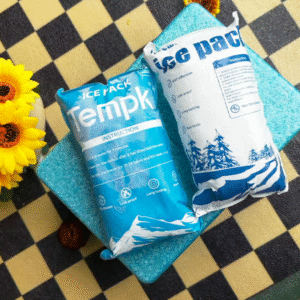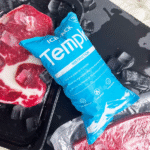Meal Prep Dry Ice Packs: Your Essential Guide for Safe and Efficient Meal Delivery
Introduction
When preparing meals for delivery, maintaining the freshness of your food throughout its journey is essential. Meal prep dry ice packs offer a solution that ensures your perishable goods stay frozen and safe. These packs are perfect for those looking to ship frozen meals, keeping them at optimal temperatures without the hassle of melting ice. In this article, we’ll discuss the advantages of using dry ice, best practices, and the safety considerations you need to be aware of.

What Are Dry Ice Packs and How Do They Work?
Dry ice packs consist of solidified carbon dioxide (CO₂) that directly sublimates from a solid to a gas without turning into liquid. This sublimation process helps keep items at extremely low temperatures, far colder than traditional ice, which is ideal for shipping or storing frozen goods. Dry ice is widely used in the food industry, especially for shipping meal kits and perishable products.
The key benefit of meal prep dry ice packs is their ability to maintain sub-zero temperatures, keeping food safely frozen during long transit times. The sublimation process also prevents any liquid residue, which is a common issue with traditional ice packs.
Key Advantages of Using Meal Prep Dry Ice Packs
-
Extended Cooling Duration
Dry ice lasts longer than regular ice, ensuring your frozen meals stay solid even on long shipping routes. -
No Residual Water
Because dry ice sublimates into gas, it leaves no mess behind, ensuring that your meal prep containers arrive dry and intact, unlike traditional ice that melts and creates soggy packaging. -
Compact and Efficient
Dry ice packs are typically more compact than gel ice packs or regular ice, saving valuable storage space and offering a more efficient way to keep items cold.
How to Use Meal Prep Dry Ice Packs for Effective Food Storage
Using meal prep dry ice packs correctly is essential for maintaining optimal temperatures and ensuring food safety. Here’s a detailed guide on how to use them effectively:
Proper Packaging
To maximize the effectiveness of dry ice, ensure that food items are securely packed in insulated containers. These containers must be able to withstand the extreme cold without compromising the food’s integrity. Packaging materials like EPS foam or vacuum-insulated panels (VIP) are ideal for creating an optimal cooling environment.
Adequate Ventilation
Since dry ice sublimates into carbon dioxide gas, it’s crucial to use packaging that allows for proper ventilation. Insulated boxes should have vents or openings to let the gas escape. This prevents pressure buildup, which could lead to the container bursting.
Correct Handling and Storage
Always handle dry ice with insulated gloves to prevent frostbite, as direct contact with skin can cause serious injuries. Store dry ice in well-ventilated areas away from living spaces to avoid carbon dioxide accumulation, which can be harmful in confined spaces.
Why Are Meal Prep Dry Ice Packs Crucial for Safe Delivery?
Meal prep dry ice packs are indispensable when shipping frozen meals over long distances, ensuring that food remains cold and safe. Below are some of the major reasons dry ice is crucial for safe food delivery:
How Dry Ice Keeps Meals Frozen Without Melt Water
Unlike traditional ice, which melts and leaves behind excess water, dry ice sublimates directly into gas, ensuring no mess. This is especially important for meal kits, where water residue can contaminate food packaging and negatively impact the quality of the meal. Dry ice maintains temperatures as low as -78.5°C (-109.3°F), ideal for keeping meals frozen during transit.
Compliance with Shipping Regulations
Certain foods and pharmaceutical products require strict temperature controls during shipping. Dry ice helps businesses comply with regulations by maintaining consistent cooling throughout the delivery process.
Best Practices for Handling and Using Meal Prep Dry Ice Packs
Here are some essential tips for effectively using dry ice packs in your meal prep process:
-
Pre-Chill Your Containers
Before placing dry ice inside, pre-chill your cooler or food storage container. This helps maintain the desired temperature longer and reduces the risk of heat transfer when dry ice is added. -
Use the Right Amount of Dry Ice
The amount of dry ice needed depends on the size of your shipment and the duration of storage or shipping. For small packages, about 5-10 pounds of dry ice per day is a good starting point. For longer shipments, you may need to adjust the amount according to temperature conditions. -
Ensure Proper Ventilation
When packing dry ice, ensure that the container is not airtight. The sublimation process releases gas, and proper ventilation is crucial for safety. Tight containers can cause dangerous pressure buildup.
The Future of Meal Prep Dry Ice Packs: Trends to Watch
As we approach 2025, several trends are emerging in the use of dry ice packs for meal prep and food delivery. These innovations aim to improve the efficiency and sustainability of cold chain logistics.
Sustainable Packaging Solutions
The trend toward eco-friendly materials is gaining momentum, with many companies adopting biodegradable insulation and packaging that can be recycled or reused. This move towards sustainability ensures that businesses can reduce waste while maintaining cold chain efficiency.
IoT-Enabled Temperature Monitoring
Internet of Things (IoT) technologies are revolutionizing cold chain logistics. IoT-enabled packaging now allows businesses and consumers to track the temperature of shipments in real-time, ensuring that food stays at the correct temperature during transit.
Hybrid Cooling Systems
Some companies are combining dry ice with phase-change materials (PCMs) to create hybrid cooling systems. This allows them to maintain different temperature zones within the same shipment, ensuring that some items stay frozen while others stay chilled.
FAQs: Your Questions Answered
How Long Do Meal Prep Dry Ice Packs Last?
Dry ice packs typically last between 18 to 24 hours, depending on the insulation used and the ambient temperature. Larger slabs of dry ice can last longer and are better for extended shipments.
Can I Use Regular Ice Instead of Dry Ice for Meal Prep?
While regular ice can be used for short-term storage, it is not as effective as dry ice for keeping food frozen over long periods. Dry ice’s ability to maintain sub-zero temperatures for extended periods makes it the superior choice.
Is It Safe to Handle Dry Ice?
Yes, but safety precautions must be followed. Always wear gloves and protective gear when handling dry ice to avoid frostbite. Ensure good ventilation when using dry ice in confined spaces to prevent carbon dioxide buildup.
Conclusion and Recommendations
Incorporating meal prep dry ice packs into your food delivery process ensures that your meals stay fresh, safe, and properly stored. By following best practices for packaging, handling, and shipping, you can provide your customers with high-quality products, free from spoilage.
Next Steps:
-
Assess your packaging needs and adjust the amount of dry ice based on shipment duration.
-
Implement IoT tracking to monitor shipment conditions in real-time.
-
Stay updated on regulatory changes regarding dry ice shipping to ensure compliance.
About Tempk
At Tempk, we specialize in providing innovative cold chain logistics solutions, ensuring that your food products, pharmaceuticals, and biotech shipments are delivered in optimal condition. Our meal prep dry ice packs, designed for efficiency and sustainability, help businesses like yours stay ahead of the curve.























